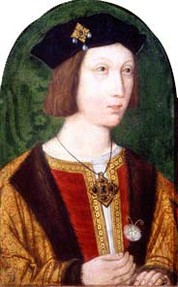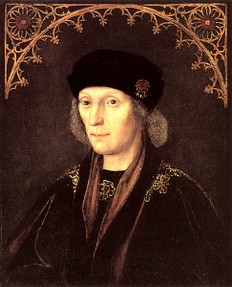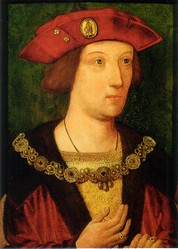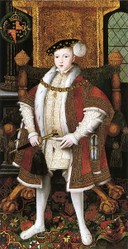 One of the most common and considered probably theories is that the young Prince of Wales died of the sweating sickness. It was a very common illness during this time, one that many who have watched The Tudors will have heard about. Very little is still understood about the sweating sickness, such as why it happened or how to cure it. Some people survived, but many died and even the noblemen and women and royalty were not immune.
One of the most common and considered probably theories is that the young Prince of Wales died of the sweating sickness. It was a very common illness during this time, one that many who have watched The Tudors will have heard about. Very little is still understood about the sweating sickness, such as why it happened or how to cure it. Some people survived, but many died and even the noblemen and women and royalty were not immune.
The theory for this comes from the fact that Catherine of Aragon was also sick for four months of their marriage together. If one had it, it is highly likely that they both succumbed to the illness. Catherine was just fortunate to recover from the ailment. She was not quite so fortunate to marry Henry VIII in 1509 and find her marriage annulled just over 20 years later.
Coincidently, Anne Boleyn was said to have almost died from the sweating sickness in 1528. There are a number of letters sent from Henry VIII bidding her to get well soon and showing hope that he would not lose her before he had the chance of marrying her. Like Catherine, she fought the sickness bug and made a full recovery. Also like Catherine, her marriage to Henry VIII was not successful and she faced a worse ending by being executed.
The sweating sickness was a form of the plague, which spread around Wales at the time Arthur was there. Henry VII didn’t realize that the plague was spreading at the time, and by the time they did find out it was too late to get the Prince and his new bride out of there and back home to safety.
There were many theories surrounding the sweating sickness. Looking into records of the illness, it seemed to favor the stronger and wealthier men, and was only in England between 1485 and 1551. Most would die within hours of contracting the disease, and those who lasted 24 hours would find that they would get better over the week. This could rule out the sweating sickness if the records are right, since Catherine was ill for four months. However, everyone is different and it could have been a different form of the plague that was similar to the sweating sickness.


 One of the most common and considered probably theories is that the young Prince of Wales died of the sweating sickness. It was a very common illness during this time, one that many who have watched The Tudors will have heard about. Very little is still understood about the sweating sickness, such as why it happened or how to cure it. Some people survived, but many died and even the noblemen and women and royalty were not immune.
One of the most common and considered probably theories is that the young Prince of Wales died of the sweating sickness. It was a very common illness during this time, one that many who have watched The Tudors will have heard about. Very little is still understood about the sweating sickness, such as why it happened or how to cure it. Some people survived, but many died and even the noblemen and women and royalty were not immune.
 Another illness that is commonly accepted at the reason for the Prince of Wales’ death is consumption. The term consumption was the olden name for tuberculosis, a disease that is still around today. Many people were said to have died from consumption, including Edward VI who also died when he was just 15 years old.
Another illness that is commonly accepted at the reason for the Prince of Wales’ death is consumption. The term consumption was the olden name for tuberculosis, a disease that is still around today. Many people were said to have died from consumption, including Edward VI who also died when he was just 15 years old.
 There is one theory that is completely wild, and suggests that Henry VII killed his own son. There is a view that Arthur was a very sickly and weak boy, and would not have made a great king. Henry decided he wanted to put his second son, who was athletic and strong, on the throne. To do that, he needed to get rid of his older son, so he arranged for his son to be poisoned after his marriage to Catherine of Aragon.
There is one theory that is completely wild, and suggests that Henry VII killed his own son. There is a view that Arthur was a very sickly and weak boy, and would not have made a great king. Henry decided he wanted to put his second son, who was athletic and strong, on the throne. To do that, he needed to get rid of his older son, so he arranged for his son to be poisoned after his marriage to Catherine of Aragon.



 Alternate History: What If Mary I Had a Child?on 01/26/2015
Alternate History: What If Mary I Had a Child?on 01/26/2015
 Francis II of France Dies: Mary, Queen of Scots Returns Homeon 12/05/2014
Francis II of France Dies: Mary, Queen of Scots Returns Homeon 12/05/2014
 Does Writedge Pay? Payment Proofon 12/03/2014
Does Writedge Pay? Payment Proofon 12/03/2014
 Alternate History: What If Lady Jane Grey Was Not Deposed?on 11/11/2014
Alternate History: What If Lady Jane Grey Was Not Deposed?on 11/11/2014



Comments
Isabelle's last child was a boy, not a girl. He was named Richard.
I think that TB also affects the bones leaving lesions as his bones are available [being in Worcester Cathedral] It might be possible to find out whether or not he did have TB.
There's just so much going on, and enough missing to speculate on ;)
Fascinating history. The lives of kings and queens has always been a subject of interest to many.